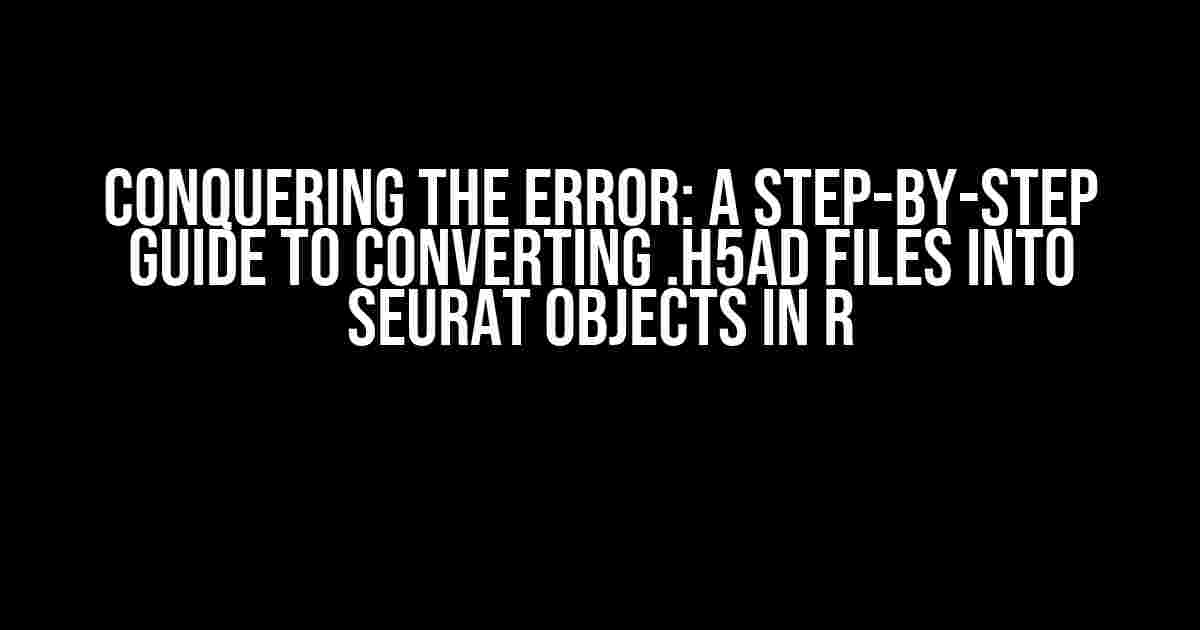Are you tired of encountering errors while trying to convert your .h5ad files into Seurat objects in R? Do you find yourself scratching your head, wondering what’s going on? Fear not, dear reader, for we’ve got you covered! In this comprehensive guide, we’ll take you by the hand and walk you through the process of successfully converting .h5ad files into Seurat objects, error-free.
What is an .h5ad File?
Before we dive into the solution, let’s take a quick detour to understand what an .h5ad file is. An .h5ad file is a type of file format used to store annotated data, typically from single-cell RNA sequencing experiments. It’s a hierarchical data format that allows for efficient storage and retrieval of large datasets.
The Error: A Brief Introduction
So, you’ve tried to convert your .h5ad file into a Seurat object in R, but instead, you’re greeted with an error message that looks something like this:
Error in h5ascripts_check_file_format(h5file) : The file 'your_file.h5ad' does not appear to be a valid h5ad file.
Don’t worry; this error is more common than you think. In fact, it’s one of the most frequently encountered errors when working with .h5ad files and Seurat objects in R.
Solution: A Step-by-Step Guide
Now that we’ve set the stage, let’s get into the nitty-gritty of solving this error. Follow these steps carefully, and you’ll be converting .h5ad files into Seurat objects in no time!
Step 1: Install and Load Required Packages
First things first, you need to make sure you have the necessary packages installed and loaded. Open your R console and run the following commands:
install.packages("Seurat")
install.packages("h5adapter")
library(Seurat)
library(h5adapter)
Once you’ve installed and loaded the packages, you’re ready to move on to the next step.
Step 2: Load the .h5ad File
Now, it’s time to load your .h5ad file using the `h5ad` function from the `h5adapter` package. Run the following command:
h5ad_file <- h5ad::h5ad("your_file.h5ad")
Replace "your_file.h5ad" with the actual path to your .h5ad file. This will load the file into your R environment.
Step 3: Convert the .h5ad File into a Seurat Object
The moment of truth! Now that you've loaded the .h5ad file, it's time to convert it into a Seurat object using the `CreateSeuratObject` function from the `Seurat` package. Run the following command:
seurat_object <- CreateSeuratObject(counts = h5ad_file)
This will convert your .h5ad file into a Seurat object, which you can then use for downstream analysis.
Troubleshooting Common Errors
Even after following the steps above, you might still encounter errors. Don't worry; we've got you covered! Here are some common errors and their solutions:
Error: "The file 'your_file.h5ad' does not appear to be a valid h5ad file."
This error usually occurs when the .h5ad file is corrupted or not in the correct format. Try re-downloading the file or checking the file format using the `h5ls` command:
h5ls("your_file.h5ad")
This will give you information about the file structure and help you identify any issues.
Error: "Error in UseMethod("assay"): no applicable method for 'assay' applied to an object of class "h5ad"."
This error usually occurs when the `assay` function is not applicable to the .h5ad object. Try updating your Seurat package to the latest version using:
install.packages("Seurat")
Then, try converting the .h5ad file into a Seurat object again.
Conclusion
And that's it! With these steps and troubleshooting tips, you should be able to convert your .h5ad file into a Seurat object in R without any issues. Remember to always check your file format, update your packages regularly, and seek help when needed.
Now, go forth and conquer the world of single-cell RNA sequencing!
Frequently Asked Question
Stuck with converting .h5ad files into Seurat objects in R? Don't worry, we've got you covered! Here are some frequently asked questions and answers to get you back on track.
Q1: What is the most common error encountered while converting a .h5ad file into a Seurat object in R?
The most common error is the "Error in load_h5(filename) : unable to load HDF5 file" error, which usually occurs due to issues with the file path or file format.
Q2: How do I check if my .h5ad file is corrupted or not?
You can try loading the .h5ad file using the `h5ls` command in your terminal or command prompt. If the file is corrupted, you'll see an error message indicating the issue. Alternatively, you can try loading the file in a different software, such as Scanpy or HDFView, to see if it loads correctly.
Q3: What should I do if my .h5ad file is too large to load into R?
You can try downsampling your data using the `adata.pp.downsample` function in Scanpy before saving it as a .h5ad file. Alternatively, you can use the `SeuratDisk` package in R, which allows you to work with large datasets by storing them on disk rather than in memory.
Q4: How do I specify the assay to use when converting a .h5ad file to a Seurat object?
You can specify the assay to use by adding the `assay` argument to the `read_h5ad` function. For example, `read_h5ad(file, assay = "RNA")` would load the RNA assay from the .h5ad file.
Q5: What if I get an error saying that the .h5ad file is not a valid Seurat object?
This error usually occurs if the .h5ad file was not created using Seurat or was not saved correctly. Try re-saving the file using the `save_h5ad` function in Scanpy or Seurat, or try loading the file using a different software to see if it loads correctly.

